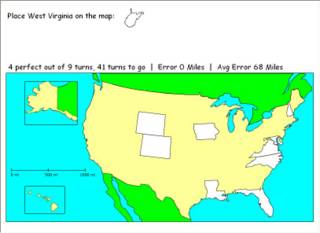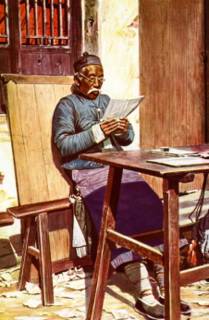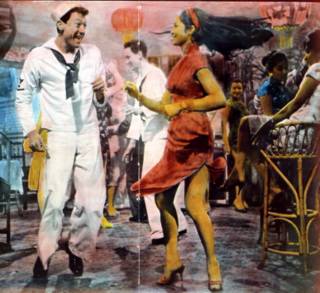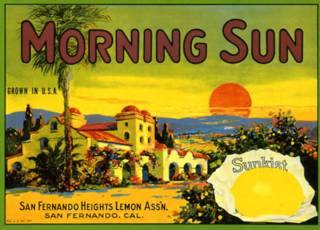
Future Architecture in Beijing
Michael Shapiro is a Bay Area writer and author of a new book about the craft of travel writing, in which he interviews a dozen-plus writers and now goes online with MSNBC in the following sequence:
Michael Shapiro Interview on MSNBC
Live Talk: At Home with the World’s Great Travel Writers
Writer Michael Shapiro answered your questions on Tuesday, December 14 at noon ETIf you've ever read Bill Bryson, Frances Mayes, Paul Theroux or any other great travel writer, you probably want to know more about their life stories, their favorite destinations, how they craft their books, and the places they call home. For the past two years Michael Shapiro, a travel journalist, has traveled throughout North America and Europe to interview these writers where they live.
The result is his new book: "A Sense of Place: Great Travel Writers Talk About Their Craft, Lives and Inspiration" published this fall by Travelers' Tales. Shapiro met Jan Morris in Wales, Frances Mayes in Tuscany, Arthur Frommer in New York, and Isabel Allende near San Francisco, among many others.
On Dec. 14 at noon ET, ask Michael about travel writing, about great travel books for holiday gifts, or about travel literature for your next destination.
Michael Shapiro is also the author of "Internet Travel Planner" and will be glad to answer questions about using the Net to learn about destinations or to find affordable flights and hotel rooms.
Michael Shapiro is the author of "A Sense of Place: Great Travel Writers Talk About Their Craft, Lives, and Inspiration" termed a "fascinating read" by National Geographic Traveler magazine and "illuminating, entertaining and insightful" by the Chicago Tribune. The book includes interviews with 18 writers, including Bill Bryson, Frances Mayes, Paul Theroux and Arthur Frommer.
A travel writer himself, Shapiro has biked through Cuba for the Washington Post, celebrated Holy Week in Guatemala for the Dallas Morning News, and floated down the Mekong River on a Laotian cargo barge for an online travel magazine. He has also contributed to the Los Angeles Times, San Francisco Chronicle and Arthur Frommer's Budget Travel magazine.
_______________________
Michael Shapiro: Greetings everyone and thanks for joining me. I’m ready to answer your questions now. Feel free to ask me about anything ranging from the craft of travel writing to using the Internet for travel.
_______________________
Chicago, IL: Hi Michael, I have traveled extensively around western Ukraine. This is the most beautiful land I have seen and truly an undiscovered gem. Assuming their current political issues are brought under control, do you think that these areas have the chance of becoming the next Prague or Budapest? What do you think it will take for travelers to be inspired to visit this region? Thanks!
Michael Shapiro: Though I’ve yet to visit Ukraine, I’ve heard it’s a beautiful place. You’re right; typically most travelers will wait until a country’s political situation settles down. When that happens, Ukraine very well could be the next hot destination, but the whims of travelers are about as predictable as the stock market. One thing that would surprise me is if Afghanistan became a hot place to visit in three to five years. Just a Southeast Asia (especially Vietnam, Cambodia and Laos) became hot some years after the war there, I believe Afghanistan, with its ancient culture and hospitable people, will become popular soon, if stability takes hold. Let’s hope for the best for the Afghani people. After so many years of strife they deserve some peace.
By the way, I think your city, Chicago, is a great place to visit; nothing like a weekend ball game at Wrigley Field.
_______________________
New York, NY: Travel and writing are the two things I really love, and I've been thinking about taking the travel-writing plunge. What would you say is the best starting point for a completely unknown, but terribly passionate, traveler/writer?
Michael Shapiro:
We’re just starting and already I see several questions asking about how to become a travel writer. First, let me say it took me years to become adept at writing and to learn the difference between a travel journal and writing for publication. But there are people who haven’t had much experience and manage to get their writing published. In my new book, A Sense of Place, I interviewed 18 travel writers and each had different advice for writers. Jeff Greenwald said learning to write is like learning to play the oboe. It takes years of practice. Peter Matthiessen said he had to write a lot of “bad short stories” before he became a talented writer of travel for The New Yorker. And Sara Wheeler emphasized that one should read voraciously. She said she’s stunned that many of her writing students don’t read much.
Several strategies: read lots of travel and other types of writing; join a writers group and get feedback from other aspiring and working writers. Take a seminar: a bookstore near San Francisco called Book Passage offers an annual travel writers conference in August where you can take classes from legends like Tim Cahill and Jan Morris. And keep submitting your articles to all sorts of publications – persistence pays off.
And your passion will guide you - without that passion, good travel writing is almost impossible.
_______________________
New York, NY: What do you think about the new "aggregator" sites. Are they really better than Orbitz and Expedia?
Michael Shapiro: The new aggregator sites are one more option for travelers to search for web fares, but certainly not be-all and end-all. We’re a long way from one-stop shopping. For those who haven’t heard: aggregator or “metasearch” sites scan dozens of other travel web sites searching for the best deals on flights, hotels and rental cars. A good example of this is Sidestep.com which has been around for three or four years. Sometimes I’ve found better deals at Sidestep than elsewhere but one has to download the software into your computer – it isn’t just a web search. Sidestep says that starting next month it will offer web search too. The most exciting new aggregator, the one that seems to have the most potential is called Kayak.com which is now in beta. That means you can try it out now if you like and use it, but it’s not fully up to speed yet. Gary Lee at The Washington Post did a nice job writing about aggregators last month, see:
http://www.washingtonpost.com/wp-dyn/articles/A45450-2004Nov12.html
___________________
Mesa, AZ: I want to take long bamboo chimes to my grandson in Chicago. It has 4 tubes on it. Would I put it in my suitcase and check it or carry it on the airline with me? I worry that the scanner may see the bamboo and think it is a bomb. Please advise me...we are flying American West. I did wrap the other gifts I plan to check in luggage. Thanks.
Michael Shapiro: What an original question - I'd call the airline in advance and seek their advice - good luck!
_______________________
Little Rock, AR: I work for a non-profit group and travel occasionally to countries that are not commonly considered tourist sites. There is not a lot of information in the travel industry (books, websites, etc.) about these countries and I would like to share my experiences and recommendations with the world. What is the best way to go about this? If I wrote a book, would I have any legal obligation to my employer since they are the one sending me to these less-traveled places? Thanks!
Michael Shapiro: I doubt you'd have any legal obligation but check with your employer first - that seems the fair thing to do. And I find the web is an amazing source for destination info and a great place to share your findings. You may not get paid but you can have the satisfaction of sharing your discoveries on sites like www.bootsnall.com that convey your impressions and pictures to the world.
_______________________
Manchester, NH: After interviewing so many great travel writers, I was wondering if you think it's more their literary abilities/talent or the places they write about that make their works sing?
Michael Shapiro: Great question. I think it's their literary skills primarily and also their curiosity. I think a good writer could write about almost any place and make it interesting. Though certainly choice of place has something to do with it. When Tim Cahill is pursuing tigers along the Iran/Iraq border, I'm interested. But I'll follow my favorite writers -- Pico Iyer, Bill Bryson, Jan Morris, and so many of the others I interviewed for "A Sense of Place" -- just about anywhere.
_______________________
New Orleans, LA: Is it safe to travel to Israel? I've wanted to go for quite some time but my husband is too scared.
Michael Shapiro: Perhaps right now there's someone in Israel wondering if it's safe to go to New Orleans. I don't mean to make light of the question; it's reasonable to be concerned about traveling to Israel but people in other parts of the world wonder about coming to our big cities. My inclination is usually to go - millions of people there survive every day, but if your husband is too uncomfortable the worry could make your trip unpleasant. Ultimately it's a personal choice. I often think of Pico Iyer, the travel writer who is constantly traveling the world and the closest he came to dying was at his family's home in Santa Barbara during a forest fire. So you never know.
_______________________
Los Angeles, CA: I used to get really good airfares on Priceline, but it seems like they've got the same as everyone else right now. True...or just my personal experience?
Michael Shapiro: Probably somewhat true. Regular airfares now are relatively low (and occupancy is high) so it's hard for Priceline to offer steep enough discounts to make their restrictions worth accepting (you can't change or reschedule flights, no FF miles, etc.) But I still find Priceline can offer good values for hotel rooms and rental cars. You can still find nice three-star hotels in many cities for about $50-60, a great savings over standard prices. Before you bid, check biddingfortravel.com and betterbidding.com to see what others are paying.
_______________________
New York, NY: I guess my question is less about becoming a good travel writer than a published one. I've been published in other mediums. Can I take those clips to a travel magazine, or do I need to really have travel writing clips. How do I get hired (just moved here from the Midwest)?
Michael Shapiro: Yes, all clips, as long as they're well written, are helpful. Editors want to see that you can write. If you can write a colorful feature or well researched news story, that's a big plus. Magazines typically want story queries - that means you approach them with an idea and if they like it and feel you have the skill to write well, they may assign the story. One thing I'd advise: start as a freelance writer doing one piece at a time. Unless you have a lot of experience it's unlikely a magazine will hire you as an editor or regular contributor.
_______________________
Boston, MA: How does one begin submitting articles to magazines about traveling? Is it better to send a query proposing an article, or an already completed article? And, perhaps most importantly, are payment amounts pre-set, or how do magazines negotiate them?
Michael Shapiro: It varies: newspaper travel sections typically want completed stories sent to them on hard copy. Some accept email submissions. You can often call a publication and ask for its submission guidelines -- sometimes these are posted online.
Magazines want queries. These are well researched proposals, typically about a page long, no more than two pages long, outlining the idea and why you're the right person to do the story. Then there's is typically follow up if the editor is interested. When can you go? How much will payment be. Most publications typically have a range and new writers start at the lower end of that range. Typical magazine pay can be anywhere from 25 cents to $3 a word but don't expect to get to even $1 a word till you've done quite a few pieces.
Newspapers pay much less, perhaps $250 for a 1500-word story. Sometimes you can sell pictures to newspaper travel sections to augment your income. You can negotiate with both newspaper and magazine editors but until I've sold my first piece to a publication I don't negotiate too hard.
_______________________
Phoenix, AZ: Hello Michael, I am a travel agent and I've always dreamed of becoming a travel writer. What do I need to do to get started? I have extensive experience traveling and I am a very good writer. Thanks
Michael Shapiro: I've covered some of the basics earlier in this conversation but you have one thing in your favor: you're a travel agent. So you know about some destinations and you can travel cheaply. Because you can't expect to make much money as a travel writer early in your career, it's best for aspiring travel writers to have the idea that they perhaps can supplement their income, or defray some of their travel expenses, by writing.
One issue you should be aware of: many of the top newspapers and magazine will *not* accept stories based on travel that is subsidized by hotels or airlines. So if you get a price break that disqualifies you from writing that story for the NY Times, Washington Post, SF Chronicle and many others. The reason is simple: if a hotel knows who you are, you'll possibly get different service than other guests. Better publications want you to remain anonymous.
So how can you make any money - good question. Don't count on it but please do write if you're passionate about it.
_______________________
Stowe, VT: How do you (and the writers you interviewed) think travel writing differs from say, sports writing? Or fiction? Or hard news reporting?
Michael Shapiro: This is a good question. Many of the travel writers I interviewed in A Sense of Place don't consider themselves travel writers. They're just writers and many feel the best writing isn't really about travel but about their perceptions of the world. Jan Morris calls it "egobiography." And if you look at some of the masters of the form, people such as Paul Theroux, Jonathan Raban and Redmond O'Hanlon, their books often read like novels more than travel narratives.
That said, I think travel writing really is a genre. It brings together so much: history, sensory awareness, architecture, interactions with people, and on and on. Really I think the best travel writers are Renaissance people; they have such a breadth of knowledge. And the clear distinction between fiction is that it's not ok in travel writing to make stuff up. Some writers reorder events but if you're creating characters, that's fiction, not travel writing.
_______________________
Phoenix, AZ: Do travel writers/editors ever hire researchers to travel for them? I'm not a writer, but would love to travel for free. Is there any kind of job like that?
Michael Shapiro: I can't imagine writers hiring people to travel for them; you have to rely on your own impressions to write travel well, but there are jobs at travel magazines, such as fact checkers. This can be a good way to learn the business from the inside and get a sense of what editors want. Once you're known, you're more likely to have your story pitches considered.
_______________________
Lancaster, PA: Hi Michael: I enjoy your work. I am very interested in submitting for print travel articles and features. I have traveled extensively, and people love it when I recommend destinations, what to do when there, fun and delicious restaurants, best beaches, mountain hikes, where to find the hidden jewels, etc. Where does one start? To whom should I submit articles, and how? Thank you.
Michael Shapiro: Every writer's path is different: I started as a news reporter and kept traveling on my vacations, and then I wrote these stories up for newspaper travel sections. I find that newspapers are the best places for breaking into print.
But as I bet you know, the Web offers so much opportunity for writers who are coming up. Some of the best travel writing I've seen lately has been on Worldhum.com -- two writers who until recently weren't that well known are included in "The Best American Travel Writing 2004".
I'd also recommend sending stories to Travelers' Tales, the San Francisco-based publisher of travel literature. They have country guides, for example a collection of true stories about Greece, and other theme guides like their annual roundup called "The Best Travelers' Tales 2004".
So there are more options than ever. As Bill Bryson said in our interview for "A Sense of Place": there are so many options for travel writers compared to fiction writers for example. It's much easier to get a story published about a weekend getaway than it is to get your fiction published.
Thanks for the kind words about my work.
_______________________
Atlanta, GA: I'd really love to become a travel writer. How do most people get their start in this industry? What's the average yearly salary?
Michael Shapiro: The salary question is almost impossible to answer and gave me a bit of a chuckle because it's so difficult to get writing jobs in this business. Most of the writing you read in travel magazines and newspapers is written by freelance writers. Of course these magazines have staffs but typically the staff is a small group of editors. And it usually takes some time writing before one can because an editor. So start by writing and if you love it stay in the biz and you may end up with a full time job. For me news journalism was the way to make a living but that's getting harder these days too.
_______________________
New York, NY: What do you think makes a great travel writer/travel writing?
Michael Shapiro: Curiosity and openness. When I asked Barry Lopez (author of Arctic Dreams) about this, he said, "I listen." So you do need to listen and not just to people you meet but to the ancient whispers carried by the wind. In less poetic terms: get a feel for the place; I agree with Jan Morris and Bill Bryson: the best way to get a feel for the city is to simply walk around with all your antennae out.
The writing is the hard part. I'm attracted to stories that make me care about the people the author meets and evoke the landscape. In some of the best travel writing the landscape is almost another character in the larger story. I could go on but I think the best writers say it better for themselves.
Some of their comments are on my site, www.nettravel.com, which also links to the intro and the Tim Cahill chapter of my book, so you can get a sneak peak if you like.
_______________________
Anonymous: In interviews, obviously, one would want to have done research, be a good listener, form questions that haven't been asked a thousand times before, etc. But is there some little thing, some tactic you've developed, that helps you get to a unique place in an interview?
Michael Shapiro: You're right about being a good listener - that's key. For me much of the work is preparation. Before the interview, I learn as much as possible about the interviewee, from books, magazines and the Web. One thing is to ask friendly but not fawning, questions at the beginning and cover more controversial subject later, after you've gained that person's trust. I think the key is that you show the interviewee that you care about him or her, part of that is preparation, another part is eye contact, and that you're passionate about their work and they're likely to open up. And of course, avoid judgment. Finally, don't fear silence. A short lull in the conversation could lead your subject to say something they hadn't considered previously.
_______________________
Ukiah, CA: Is there a list of B&Bs in the London area?
Michael Shapiro: I imagine many of the big listing sites, like bedandbreakfast.com have sections on London. You can use Google to find sites specific to London B&Bs.
_______________________
Chicago, IL: How do travel writers choose which destinations to cover?
Michael Shapiro: Mostly writers come up with their own ideas, occasionally an editor will suggest a place to a veteran writer. Typically they follow their heart and go to the places that call them. Other times it's more pragmatic. As a writer based near San Francisco, I often write stories about northern California for publications outside the area. I do this because many publications and their readers are interested in the area, and local travel minimizes my expenses.
_______________________
Washington, DC: I'm planning to go to Paris for my birthday at the end of January but the dollar news looks awful. It's dampening my spirits and my planning. Am I realistic in thinking that my budget is significantly hampered or should I be finding someplace nice in the U.S. as an option?
Michael Shapiro: It's true that the dollar's plunge has made Europe more expensive. On the bright side, late January is a great time to get ultracheap airfares. Last winter I travel from SF to Milan to London and back for less than $500 including all taxes and fees.
The biggest expense is hotel but many hotels offer deals in the winter when occupancy is low. Check this site's daily newsletter to stay abreast of specials -- other sites like smarterliving.com list deals too.
_______________________
Columbia, MO: Hi, I am a college student studying journalism. What advice would you give me on how to break into travel writing?
Michael Shapiro: Just keep writing. And don't focus just on travel writing - do all sorts of writing. Pico Iyer told me that during his graduate school years he wrote lots of book reviews and when the recruiter from Time magazine arrived he had lots of articles to show him. And of course the more you write, the better you get. It's a practice.
_______________________
Michael Shapiro: That's all the time we have for today. I wish I could have answered everyone's questions but if you did have a question about travel writing that didn't get addressed, perhaps you'll find the answer in "A Sense of Place". The writers I interview in there say it better than I do.
Thanks for spending the past hour with me - it's been great fun to have this global conversation. And best to all of you for the holidays and new year.
-Michael















